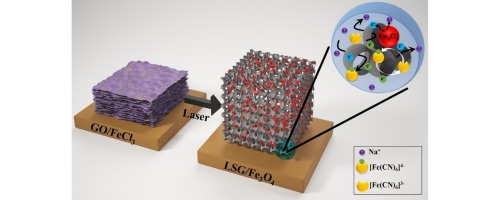当前位置:
X-MOL 学术
›
Nano Today
›
论文详情
Our official English website, www.x-mol.net, welcomes your feedback! (Note: you will need to create a separate account there.)
Boosting the capacitance and voltage of aqueous supercapacitors via redox charge contribution from both electrode and electrolyte
Nano Today ( IF 17.4 ) Pub Date : 2017-08-01 , DOI: 10.1016/j.nantod.2017.06.009 Jee Y. Hwang , Maher F. El-Kady , Mengping Li , Cheng-Wei Lin , Matthew Kowal , Xu Han , Richard B. Kaner
Nano Today ( IF 17.4 ) Pub Date : 2017-08-01 , DOI: 10.1016/j.nantod.2017.06.009 Jee Y. Hwang , Maher F. El-Kady , Mengping Li , Cheng-Wei Lin , Matthew Kowal , Xu Han , Richard B. Kaner

|
Abstract Supercapacitors are evolving into an important component in energy storage technology with the capability for storing and discharging energy very quickly and effectively. State-of-the-art supercapacitors feature activated carbon electrodes impregnated with a non-aqueous electrolyte (typically acetonitrile) that operate at voltages between 2.2–2.7 V. Unfortunately, activated carbons have low specific capacitance (100–120 F g −1 ) in organic electrolytes which severely limits the energy density of supercapacitors. In addition, organic solvents are often flammable leading to safety and environmental concerns. Aqueous electrolytes, on the other hand, are safer, cheaper and have higher ionic conductivity, promising higher capacitance electrodes. However, the low voltage window enforced by the low decomposition voltage of water around 1.23 V is a major challenge. Here, we demonstrate symmetric supercapacitors operating at an ultrahigh voltage of 1.8 V that can provide specific electrode capacitances up to 716 F g −1 , which is higher than traditional activated carbon electrodes. This is possible through designing both the electrode and electrolyte to work synergistically towards improving not only the capacitance of the electrodes, but also the voltage and cycling stability of the supercapacitor. We also demonstrate by using a simple laser technique the possibility of fabricating micro-supercapacitors with great potential for miniaturized electronics. This work provides an effective strategy for designing and fabricating aqueous supercapacitors that hold promise for a sustainable energy future.
中文翻译:

通过电极和电解质的氧化还原电荷贡献提高水性超级电容器的电容和电压
摘要 超级电容器正在发展成为储能技术的重要组成部分,具有非常快速有效地储存和释放能量的能力。最先进的超级电容器具有浸渍有非水电解质(通常为乙腈)的活性炭电极,可在 2.2-2.7 V 的电压下工作。不幸的是,活性炭的比电容低(100-120 F g -1 )在有机电解质中,这严重限制了超级电容器的能量密度。此外,有机溶剂通常是易燃的,导致安全和环境问题。另一方面,水性电解质更安全、更便宜并且具有更高的离子电导率,有望成为更高电容的电极。然而,水的低分解电压在 1 左右强制执行低电压窗口。23 V 是一个重大挑战。在这里,我们展示了在 1.8 V 超高电压下运行的对称超级电容器,它可以提供高达 716 F g -1 的特定电极电容,这高于传统的活性炭电极。通过设计电极和电解质协同工作,不仅可以提高电极的电容,而且可以提高超级电容器的电压和循环稳定性,从而实现这一点。我们还通过使用简单的激光技术证明了制造具有微型电子产品潜力的微型超级电容器的可能性。这项工作为设计和制造有望实现可持续能源未来的水性超级电容器提供了一种有效的策略。我们展示了在 1.8 V 超高电压下运行的对称超级电容器,它可以提供高达 716 F g -1 的特定电极电容,这高于传统的活性炭电极。通过设计电极和电解质协同工作,不仅可以提高电极的电容,而且可以提高超级电容器的电压和循环稳定性,从而实现这一点。我们还通过使用简单的激光技术证明了制造具有微型电子产品潜力的微型超级电容器的可能性。这项工作为设计和制造有望实现可持续能源未来的水性超级电容器提供了一种有效的策略。我们展示了在 1.8 V 超高电压下运行的对称超级电容器,它可以提供高达 716 F g -1 的特定电极电容,这高于传统的活性炭电极。通过设计电极和电解质协同工作,不仅可以提高电极的电容,而且可以提高超级电容器的电压和循环稳定性,从而实现这一点。我们还通过使用简单的激光技术证明了制造具有微型电子产品潜力的微型超级电容器的可能性。这项工作为设计和制造有望实现可持续能源未来的水性超级电容器提供了一种有效的策略。高于传统活性炭电极。通过设计电极和电解质协同工作,不仅可以提高电极的电容,而且可以提高超级电容器的电压和循环稳定性,从而实现这一点。我们还通过使用简单的激光技术证明了制造具有微型电子产品潜力的微型超级电容器的可能性。这项工作为设计和制造有望实现可持续能源未来的水性超级电容器提供了一种有效的策略。高于传统活性炭电极。通过设计电极和电解质协同工作,不仅可以提高电极的电容,而且可以提高超级电容器的电压和循环稳定性,从而实现这一点。我们还通过使用简单的激光技术证明了制造具有微型电子产品潜力的微型超级电容器的可能性。这项工作为设计和制造有望实现可持续能源未来的水性超级电容器提供了一种有效的策略。我们还通过使用简单的激光技术证明了制造具有微型电子产品潜力的微型超级电容器的可能性。这项工作为设计和制造有望实现可持续能源未来的水性超级电容器提供了一种有效的策略。我们还通过使用简单的激光技术证明了制造具有微型电子产品潜力的微型超级电容器的可能性。这项工作为设计和制造有望实现可持续能源未来的水性超级电容器提供了一种有效的策略。
更新日期:2017-08-01
中文翻译:

通过电极和电解质的氧化还原电荷贡献提高水性超级电容器的电容和电压
摘要 超级电容器正在发展成为储能技术的重要组成部分,具有非常快速有效地储存和释放能量的能力。最先进的超级电容器具有浸渍有非水电解质(通常为乙腈)的活性炭电极,可在 2.2-2.7 V 的电压下工作。不幸的是,活性炭的比电容低(100-120 F g -1 )在有机电解质中,这严重限制了超级电容器的能量密度。此外,有机溶剂通常是易燃的,导致安全和环境问题。另一方面,水性电解质更安全、更便宜并且具有更高的离子电导率,有望成为更高电容的电极。然而,水的低分解电压在 1 左右强制执行低电压窗口。23 V 是一个重大挑战。在这里,我们展示了在 1.8 V 超高电压下运行的对称超级电容器,它可以提供高达 716 F g -1 的特定电极电容,这高于传统的活性炭电极。通过设计电极和电解质协同工作,不仅可以提高电极的电容,而且可以提高超级电容器的电压和循环稳定性,从而实现这一点。我们还通过使用简单的激光技术证明了制造具有微型电子产品潜力的微型超级电容器的可能性。这项工作为设计和制造有望实现可持续能源未来的水性超级电容器提供了一种有效的策略。我们展示了在 1.8 V 超高电压下运行的对称超级电容器,它可以提供高达 716 F g -1 的特定电极电容,这高于传统的活性炭电极。通过设计电极和电解质协同工作,不仅可以提高电极的电容,而且可以提高超级电容器的电压和循环稳定性,从而实现这一点。我们还通过使用简单的激光技术证明了制造具有微型电子产品潜力的微型超级电容器的可能性。这项工作为设计和制造有望实现可持续能源未来的水性超级电容器提供了一种有效的策略。我们展示了在 1.8 V 超高电压下运行的对称超级电容器,它可以提供高达 716 F g -1 的特定电极电容,这高于传统的活性炭电极。通过设计电极和电解质协同工作,不仅可以提高电极的电容,而且可以提高超级电容器的电压和循环稳定性,从而实现这一点。我们还通过使用简单的激光技术证明了制造具有微型电子产品潜力的微型超级电容器的可能性。这项工作为设计和制造有望实现可持续能源未来的水性超级电容器提供了一种有效的策略。高于传统活性炭电极。通过设计电极和电解质协同工作,不仅可以提高电极的电容,而且可以提高超级电容器的电压和循环稳定性,从而实现这一点。我们还通过使用简单的激光技术证明了制造具有微型电子产品潜力的微型超级电容器的可能性。这项工作为设计和制造有望实现可持续能源未来的水性超级电容器提供了一种有效的策略。高于传统活性炭电极。通过设计电极和电解质协同工作,不仅可以提高电极的电容,而且可以提高超级电容器的电压和循环稳定性,从而实现这一点。我们还通过使用简单的激光技术证明了制造具有微型电子产品潜力的微型超级电容器的可能性。这项工作为设计和制造有望实现可持续能源未来的水性超级电容器提供了一种有效的策略。我们还通过使用简单的激光技术证明了制造具有微型电子产品潜力的微型超级电容器的可能性。这项工作为设计和制造有望实现可持续能源未来的水性超级电容器提供了一种有效的策略。我们还通过使用简单的激光技术证明了制造具有微型电子产品潜力的微型超级电容器的可能性。这项工作为设计和制造有望实现可持续能源未来的水性超级电容器提供了一种有效的策略。



























 京公网安备 11010802027423号
京公网安备 11010802027423号